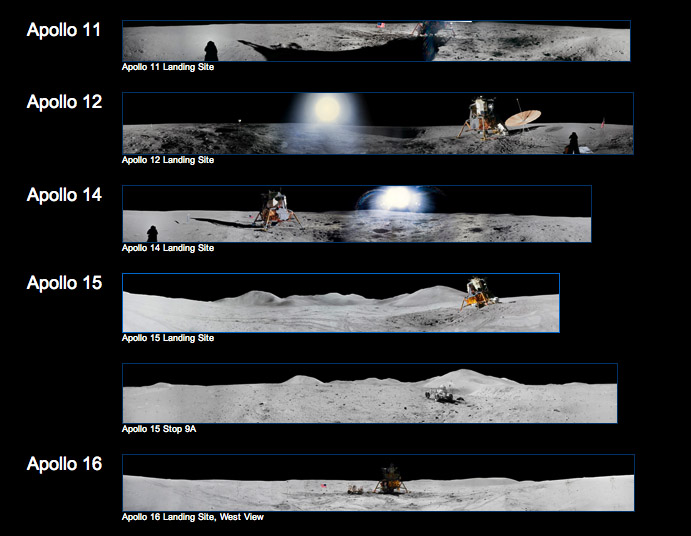December 20, 2017
Ultimate Pans
Originally published June 21, 2008

Apollo panoramas re-assembled and available at Lunar and Planetary Institute, Houston, TX
The Lunar and Planetary Institute has just added new resources to their Lunar Science & Exploration web portal. The illustration here shows thumbnails of six of the 22 panoramas now available at the LPI site. All of the pans were assembled from newly digitized images of the Hasselblad camera photographs taken on the surface. The top Apollo 15 pan dramatically shows the tilt of the Lunar Module lander - it came down on the rim of a small crater with one of the lander's legs inside the crater. Each of the pans can be enlarged and you can pan across the pans. This is a nice job of digitizing and mosaicking by the folks at the Information Resources Directorate at Johnson Space Center.
Chuck Wood
Yesterday's LPOD: Greek Moonrise
Tomorrow's LPOD: Percy Who?
COMMENTS
1. Superb!!! Thanks LPI and Chuck! Let's explore!
-- Danny Caes.
2. I didn't know about Apollo 15 tilt! I like it when I learn something new :)
-- Aleksander Božič aka SandiBandi
3. Yeah...a credit to LPI for this wonderful series of panoramas that brings the user into places one just wants to investigate more. The software -- Zoomify http://www.zoomify.com -- that LPI have used here is also very good, so a credit and mention to them, too. John----
4. Aleksander, Apollo 15's tilted LM Falcon was also called "The leaning tower of Pisa"! (mentioned in the article To The Mountains of the Moon by Kenneth F. Weaver, in the National Geographic of February 1972 (this is a splendid article on Apollo 15! Lots of orbital and surface photographs in it! And also some of Apollo 15's pans; assembled "the old fashioned way").
-- Danny Caes.
5. Thx Danny! Do list for this summer has N.1 - invastigate all the Apollos ! ;)
ABaSB
6. If you look closely at the Apollo 15 engine bell you can make out some of the impact damage caused by it striking the regolith. This LM touched down at approximately twice the regular descent rate. Before today, I had never heard of the engine bell impact or noticed the damage caused by the higher terrain. Neat!!
Jeff G.
7. I see in various places where two of the rear pads for Apollo 15 were in the shallow crater (Rear View of Apollo15 in crater, Another Rear View). However, Apollo 14 came very close to a very small, deep looking crater for one landing pad (Apollo 14 landing pad near crater).
-- jfincannon
8. I wonder why there was no article on Apollo 12 in the National Geographic. Apollos 7, 9, 10, and 13 too: no articles in N.G. ...
Apollos 8, 11, 14, 15, 16, 17, and also Skylab and the ASTP (Apollo-Soyuz Test Project) appeared well-illustrated in N.G.
The articles on Apollo 16 and ASTP were a bit short, with few photographs.
-- Danny Caes.
COMMENTS?
Register, Log in, and join in the comments.



